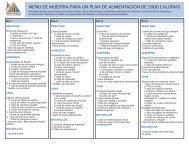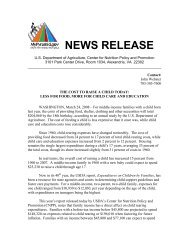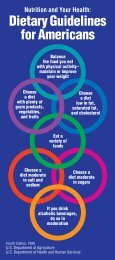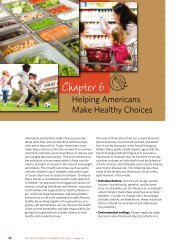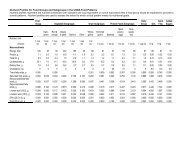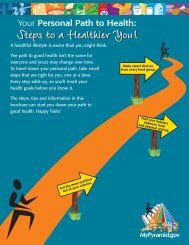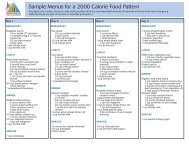Elderly Nutrition - Center for Nutrition Policy and Promotion - US ...
Elderly Nutrition - Center for Nutrition Policy and Promotion - US ...
Elderly Nutrition - Center for Nutrition Policy and Promotion - US ...
Create successful ePaper yourself
Turn your PDF publications into a flip-book with our unique Google optimized e-Paper software.
<strong>and</strong> the Stages of Change instrument<br />
consisted of eight separate questions,<br />
four each <strong>for</strong> fruits <strong>and</strong> <strong>for</strong> vegetables<br />
(box 2). Questions on the Stages of<br />
Change instrument asked older adults<br />
the number of servings of fruits <strong>and</strong><br />
vegetables they were eating, how long<br />
they had been eating that number of<br />
servings, <strong>and</strong> whether they were<br />
seriously thinking of increasing this<br />
number either in the next 30 days or<br />
in the next 6 months. These questions<br />
were based on the criteria of the<br />
Transtheoretical Model Stages of<br />
Change construct (W.D. Hart, personal<br />
communication, October 19, 2001).<br />
Thus, the questions were based on a<br />
st<strong>and</strong>ardized length of time individuals<br />
had been working on, or intended to<br />
implement, a behavior change.<br />
The Extension nutrition specialists,<br />
dietetic nutrition professionals, <strong>and</strong><br />
county Extension agents (who also<br />
field tested the teaching materials)<br />
tested the instruments <strong>for</strong> content<br />
<strong>and</strong> face validity. The instruments<br />
were reviewed <strong>for</strong> content accuracy<br />
<strong>and</strong> suitability <strong>for</strong> the older adult<br />
target audience, after which appropriate<br />
adjustments were made.<br />
Extensive field testing addressed any<br />
issues related to reliability. Cronbach’s<br />
Alpha was used to test internal<br />
consistency of the instruments. The<br />
instrument Checkup on Your Good<br />
Eating Practices tested at an alpha of<br />
.77. The subscale <strong>for</strong> Stages of Change<br />
<strong>for</strong> fruit-related behaviors tested at<br />
an alpha of .53, <strong>and</strong> the subscale <strong>for</strong><br />
Stages of Change <strong>for</strong> vegetable-related<br />
behaviors tested at an alpha of .63.<br />
Research in applying the Stages of<br />
Change construct to measurement<br />
of behavior change of nutritional<br />
behaviors is relatively new. There<strong>for</strong>e,<br />
the alpha levels were considered<br />
acceptable (Nunnally, 1967).<br />
Box 2 – Major Survey Instruments 1<br />
Checkup on Your Good Eating Practices: Example questions<br />
(Answer choices: Almost never, Seldom, Often, Almost always, <strong>and</strong> Doesn’t apply.)<br />
What do you do?<br />
Include at least three food groups in my breakfast<br />
(e.g., milk, fruit, <strong>and</strong> grains such as bread <strong>and</strong> cereal)?<br />
Eat 3 or more servings of different vegetables daily?<br />
Eat at least 1 serving of vitamin A-rich foods daily<br />
(e.g., dark green, leafy [spinach, kale, broccoli] <strong>and</strong> deep yellow<br />
[sweet potatoes, cantaloupe, apricots])?<br />
Choose potatoes prepared in lower fat ways (not fried)?<br />
Eat 2 or more servings of different fruits daily?<br />
Choose at least 1 serving of vitamin C-rich foods daily<br />
(e.g., orange juice, grapefruit, broccoli, cabbage, tomatoes)?<br />
Include at least 1 serving from each of the five food groups<br />
(i.e., grains, fruits, vegetables, meat group, <strong>and</strong> milk products)?<br />
Stages of Change: Questions<br />
Separate questions were asked <strong>for</strong> fruit- <strong>and</strong> vegetable-eating behaviors.<br />
How many servings of fruits (vegetables) do you eat each day?<br />
0<br />
1 or 2<br />
3 or 4<br />
5 or more<br />
Don’t know<br />
About how long have you been eating this amount of fruits (vegetables)?<br />
Less than 1 month<br />
1 to 3 months<br />
4 to 6 months<br />
Longer than 6 months<br />
Don’t know<br />
Are you seriously thinking about eating more servings of fruits (vegetables)<br />
starting sometime in the next 6 months?<br />
Yes<br />
No<br />
I already eat enough<br />
Undecided<br />
Are you planning to eat more servings of fruits (vegetables) during the next 30 days?<br />
Yes<br />
No<br />
I already eat enough<br />
Undecided<br />
1 HELP evaluation instruments developed by Mary P. Clarke, PhD, RD; Jacquelyn McClell<strong>and</strong>,<br />
PhD, RD; William D. Hart, PhD, RD; <strong>and</strong> Alma Montano Saddam, PhD, RD of the <strong>Elderly</strong><br />
<strong>Nutrition</strong> Education Coordinating Group.<br />
18 Family Economics <strong>and</strong> <strong>Nutrition</strong> Review



